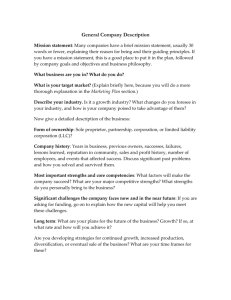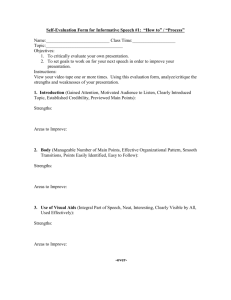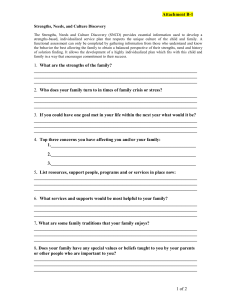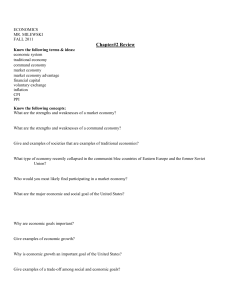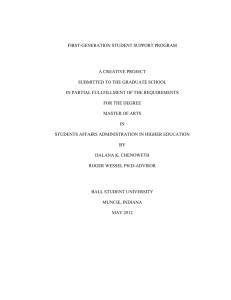First-Generation Students - Indiana State University
advertisement
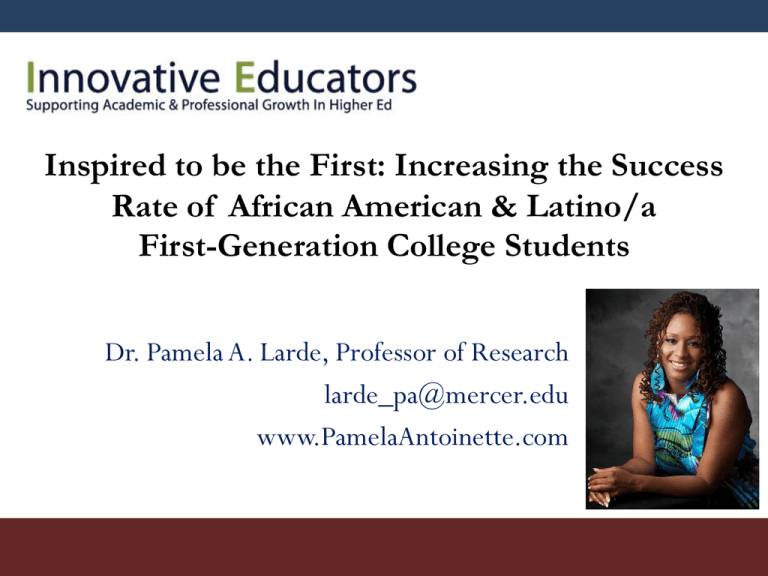
Inspired to be the First: Increasing the Success Rate of African American & Latino/a First-Generation College Students Dr. Pamela A. Larde, Professor of Research larde_pa@mercer.edu www.PamelaAntoinette.com Introduction • What to expect from this presentation • Why this study • Significance of the study The College Access Problem The College Access Problem True or False? With the development of so many new educational opportunities (such as online schools and 2 year colleges), access is really not such a problem anymore. The College Access Problem • Inferior educational resources for students living in underprivileged neighborhoods • African American and Latino/a students among the populations least likely to go to college • Lack of parental support to attend college • Limited college knowledge What’s Often Overlooked What’s Often Overlooked • How first-generation students approach overcoming challenges • The strengths and assets that first-generation students possess • How the parents of first-generation students provide support to educational endeavors Strengths Theory • The Gallup Organization’s Strengthfinder • Looking at students from a positive standpoint, rather than simply a deficit standpoint • Studies on first-generation students often come from a negative standpoint. Strengths Theory • The Gallup Organization’s Strengthsfinder • Looking at students from a positive standpoint, rather than simply a deficit standpoint • Studies on first-generation students often come from a negative standpoint. Review of Literature First-Generation Students: Five Typical (or Mythical) Challenges 1. Lack of parental support 2. Poor academic preparation 3. Limited financial resources 4. Lack of college knowledge 5. Negative cultural norms Research Site “Private University” • Private, Catholic University • Located in Midwestern United States • Approximate undergraduate population: 8,046 • 82% Caucasian, 4.6% African American, 4.1 % Latino, 4% Asian, 0.3% American Indian The Sample The Sample • • • • • • • • • 17 Students 8 African American 8 Mexican American 1 of mixed race 7 males, 10 females 3.0 GPA or higher 3 participated in pre-college program All Mexican Americans raised by both parents 2 African Americans raised by both parents How the Study Was Conducted • Phenomenological Study - Interviews • Designed 16 interview questions • Contacted students via student organization email • 28 respondents filled out an online demographic questionnaire • Selected students whose parents had no college experience • Conducted 17 tape-recorded interviews And here’s what they told us about the journey to college… The Nine Strengths 1. Not easily discouraged 2. Desires upward social mobility 3. Expects high academic performance 4. Resists stereotype threat 5. Rejects negative cultural norms 6. Aspires to pave the way for others 7. Possesses spiritual assurance 8. Has a sense of responsibility 9. Prefers self-reliance Strength #1 Not Easily Discouraged Strength #1 “No one can stop me.” Remind them of their self-determination. “Ouch and that’s it.” Encourage them to share their success strategies. “Mom never says she’s proud.” “My school didn’t offer it, so I found it.” Help them transfer their resourceful skills to college and career. Not Easily Discouraged Strength #2 Desires Upward Social Mobility Strength #2 “I want to get the education my mom couldn’t have.” “My parents worked hard for me.” “My mentor was an inspiration to me.” “I don’t want to struggle like my family.” Encourage them to talk about the future. Coach them to develop a game plan. Place role models in front of them. Desires Upward Social Mobility Strength #3 Expects High Academic Performance Strength #3 “Earning a ‘B’ is not acceptable.” Arm them with new academic strategies. “I sought out the difficult courses.” Encourage them to connect with other students. “I met with my teacher on Saturdays.” Make sure they are aware of resources. Expects High Academic Performance Strength #4 Resists Stereotype Threat Strength #4 “I stayed away from other Latinos.” “I worked hard not to be the stereotype.” “I ignored them.” “I wanted to prove myself even more.” Educate them about stereotype threat. Be aware of their racial identity development. Arm them with healthy resistance strategies. Resists Stereotype Threat Strength #5 Rejects Debilitating Cultural Norms Strength #5 “Everyone called me a sellout so I stayed to myself.” “My mom was jealous of me, so I looked to my grandmother.” “I was NOT going to live that kind of life.” Praise them for their strength. Ask questions: Learn their stories and backgrounds. Encourage them to also reject negative norms in college. Rejects Debilitating Cultural Norms Strength #6 Aspires to Pave the Way for Others Strength #6 “I have to be a good role model for my little cousins.” “If I don’t encourage my siblings, no one will.” “I am here so that I can help others get here.” Provide mentoring opportunities. Help the connect their aspirations to help others to a career. Encourage them to coordinate campus events for siblings. Aspires to Pave the Way for Others Strength #7 Possesses Spiritual Assurance Strength #7 “God blessed me with this opportunity.” Encourage them to discover their greater life purpose. “My faith in God is what helps me through.” Help them connect with a spiritual community. “I always said that God didn’t bring me this far to fail.” Encourage them to utilize those spiritual values that motivated them to seek college. Possesses Spiritual Assurance Strength #8 Has a Sense of Responsibility Strength #8 “The roles are reversed. I was my grandmother’s caretaker.” Help them effectively balance academics, activities, and job. “I started translating for my mom when I was 5.” Help them keep their academic vs. familial responsibilities in perspective. “I treated school like it was my career.” Has a Sense of Responsibility Strength #9 Prefers Self-Reliance Strength #9 “I took care of the financial aid forms myself.” Encourage them to seek out help when it is needed. “I never asked for help. If I got help, it’s because they offered.” Encourage them to use their problemsolving skills in college. “My family wanted the best for me but didn’t know how to help.” Provide team-building experiences that connect them with other students. Prefers Self-Reliance Reflecting on the Nine Strengths Do you see any of these strengths in your own students? --------- Do they see these strengths in themselves? The College Predisposition Model What does this mean for us? What does this mean for us? • How do these findings compare to what you’ve seen in the students you work with? • What is happening on the high school and college level that helps to nurture these strengths? • Where are opportunities being lost? • What can you do in your role as a professional to nurture these strengths? Questions or Comments? Digging Deeper: Resources Check out some of these links for great resources on this topic: • http://www.strengthsquest.com/home.aspx • Self-Determination Based Curriculum • http://www.firstinthefamily.org/ Thank you for participating! If you have questions or would like to discuss further, please feel free to contact me via: Email: larde_pa@mercer.edu Twitter: www.twitter.com/empoweredwriter Facebook: www.facebook.com/empoweredwriter Website: www.PamelaAntoinette.com

